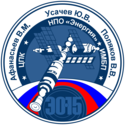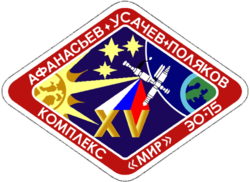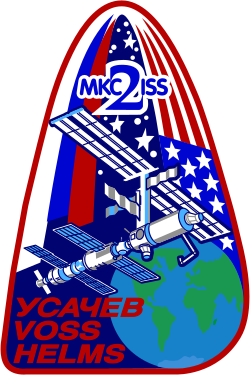Juri Wladimirowitsch Ussatschow
| Juri Ussatschow | |
|---|---|
 | |
| Land: | Russland |
| ausgewählt am | 25. Januar 1989 |
| Einsätze: | 4 Raumflüge |
| Start des ersten Raumflugs: | 8. Januar 1994 |
| Landung des letzten Raumflugs: | 22. August 2001 |
| Zeit im Weltraum: | 552d 22h 25min |
| EVA-Einsätze: | 6 |
| EVA-Gesamtdauer: | 30h 31min |
| ausgeschieden am | April 2004 |
| Raumflüge | |
| |
Juri Wladimirowitsch Ussatschow (russisch Юрий Владимирович Усачёв, wiss. Transliteration Jurij Vladimirovič Usačëv; * 9. Oktober 1957 in Donezk, Oblast Rostow, RSFSR, UdSSR) ist ein ehemaliger russischer Kosmonaut.
Ussatschow schloss 1975 die öffentliche Hochschule ab. Vom Moskauer Staatliches Luftfahrtinstitut erhielt er 1985 ein Ingenieursdiplom. Anschließend trat er eine Stelle beim Raumfahrtunternehmen RKK Energija an und war für die Ausbildung von Außenbordaktivitäten und für die Öffentlichkeitsarbeit zuständig.
Ussatschow ist verheiratet und hat eine Tochter.
Nach seinem ersten Raumflug im Jahre 1994 wurde Ussatschow zum Held der Russischen Föderation ernannt und erhielt auch die Medaille für Piloten und Kosmonauten.
Während seines vierten und letzten Raumflugs gehörte er der zweiten Langzeitbesatzung der internationalen Raumstation an und war Kommandant der ISS-Expedition 2.
Siehe auch
- Liste der Raumfahrer
- Liste der Space-Shuttle-Missionen
- Liste bemannter Missionen zur Raumstation Mir
- Liste bemannter Missionen zur Internationalen Raumstation
Weblinks
- Literatur von und über Juri Wladimirowitsch Ussatschow im Katalog der Deutschen Nationalbibliothek
- Kurzbiografie von Juri Wladimirowitsch Ussatschow bei space.kursknet.ru (englisch/russisch, archiviert 2016)
- Kurzbiografie von Juri Wladimirowitsch Ussatschow bei spacefacts.de
- Biografie von Juri Wladimirowitsch Ussatschow in der Encyclopedia Astronautica (englisch)
| Personendaten | |
|---|---|
| NAME | Ussatschow, Juri Wladimirowitsch |
| ALTERNATIVNAMEN | Усачёв, Юрий Владимирович |
| KURZBESCHREIBUNG | russischer Kosmonaut |
| GEBURTSDATUM | 9. Oktober 1957 |
| GEBURTSORT | Donezk, Oblast Rostow, RSFSR, UdSSR |
Auf dieser Seite verwendete Medien
The official crew patch for the Russian Soyuz TM-23 mission, which delivered the EO-21 crew to the space station Mir.
Patch for the Mir EO-15 expedition to the Mir space station in 1994.
The patch was redrawn by Jorge Cartes (JCR).
The STS-101 mission patch commemorates the third Space Shuttle flight supporting the assembly of the International Space Station (ISS). This flight's primary tasks are to outfit the ISS and extend its lifetime, and to conduct a spacewalk to install external components in preparation for the docking of the Russian Service Module, Zvezda, and the arrival of the first ISS crew. The Space Shuttle is depicted in an orbit configuration prior to docking with the ISS. The ISS is depicted in the stage of assembly completed for the STS-101 mission, which consists of the United States-built Unity module and the Russian-built Zarya module. The three large stars represent the third ISS mission in the assembly sequence. The elements and colors of the border reflect the flags of the nations represented by the STS-101 crew members, the United States and Russia. The NASA insignia design for Shuttle flights is reserved for use by the astronauts and for other official use as the NASA Administrator may authorize. Public availability has been approved only in the form of illustrations by the various news media. When and if there is any change in this policy, which is not anticipated, it will be publicly announced.
The STS-102 crew insignia depicts the International Space Station as it looked when Space Shuttle Discovery was docked. Visible elements include the P6 and Z1 trusses, solar arrays from the Russian segment, 2 Pressurized Mating Adapters, and the Multi Purpose Logistics Module that was temporarily attached to the underside of the Unity Node. The numbers "102" represent the mission tail number. The red, white, and blue ribbons surrounding the space station represent that this is a crew rotation flight. The colors represent the nationalities of the crewmembers (Russian and American). Underneath the ribbons are the flags of the three nations who are the major contributors to the mission (from left to right: Russia, United States, Italy). The names of the 4 permanent crewmembers are displayed in gold around the top of the emblem. Attached to the bottom are six names depicting the six rotating crewmembers (Expedition 2 on top and Expedition 1 on bottom).
The official crew patch for the Russian Soyuz TM-18 mission, which delivered the EO-15 crew to the space station Mir.
ISS Expedition 2 insignia.
The International Space Station Expedition Two patch depicts the Space Station as it appears during the time the second crew will be on board. The Station flying over the Earth represents the overall reason for having a space station: to benefit the world through scientific research and international cooperation in space. The number 2 is for the second expedition and is enclosed in the Cyrillic MKS and Latin ISS which are the respective Russian and English abbreviations for the International Space Station. The United States and Russian flags show the nationalities of the crew indicating the joint nature of the program. When asked about the stars in the background, a crew spokesman said they "...represent the thousands of space workers throughout the ISS partnership who have contributed to the successful construction of our International Space Station."







